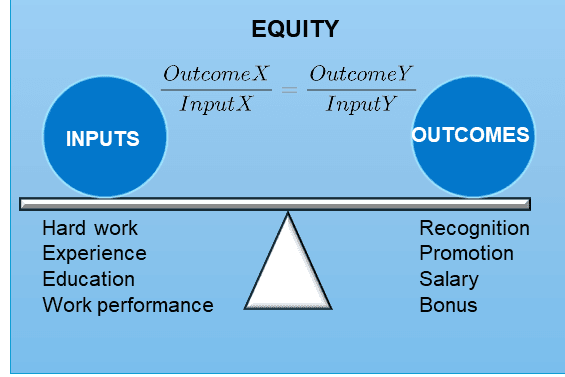What Is the Equity Theory of Motivation?
The impact of motivation on human performance is a sought-after concept in the field of human psychology. In today’s business world, motivation theories have gained significant attention, and many corporate managers advocate/implement them to improve employee retention and productivity.
One leading theory, equity theory or Adams’ equity theory of motivation, was proposed by behavioral and workplace psychologist John Stacey Adams in the 1960s. Back then, the lack of a clear understanding of the psychological perception of inequity catalyzed such an invention. Employers and governments experienced a similar dilemma because there were no standards to measure/evaluate the perception of fairness as employees’ attitudes toward the organization matter for the growth of the organization.
Before going into detail about equity theory, let’s dig into the history of the conceptual developments that led to the creation of this theory.
Relative deprivation was a concept introduced in the 1940s by Samuel Stouffer, a University of Chicago psychology professor, and colleagues in the first American Soldier journal. Several conclusions emerged based on the theoretical and experimental observations conducted in that period, mainly among American soldiers in World War II. Primarily, dissatisfaction and other similar behaviors in humans were thought to emerge as a result of the experience of acute injustice. The second is about just and relatively strong expectations—with a high educational level, people tend to have huge expectations for superior-level jobs. The third is about comparison—the injustice felt by humans is a result of the discrepancy between an achievement and an expectation of achievement. Later, the relative deprivation theory, developed to understand the psychology of soldiers, became an established theory of social science scholarship.
The relative deprivation leads to distributive justice or the concept of fair share – out of rewards. Distributive justice theory was developed by George C. Homans in 1961, and according to him, “the distributive justice among men who are in an exchange relationship with one another obtains when the profits of each are proportional to their investments.”
Just distribution—that is, the fair allocation of wealth, opportunities, welfare, jobs, etc.—is vital for any society and an essential factor for the betterment of humanity. Traditionally, people concerned with or contributed more to this field include political scientists, jurists, politicians, economists, and philosophers.
Based on these sociological and psychological studies, Adams proposed that equity/inequity is a socially dependent phenomenon entailing complex psychological and cognitive processes that can’t be evaluated by economic measurements alone. The formulation of equity theory solved the problem of the lack of a clear understanding of the exchange of fairness between employer and employee. It also proposed methods to regulate the outcome of relations and aimed to have organizational and social consequences. Practicing fairness in an organization aims at reducing financial consequences that might have been resulting from an unsatisfied employee. Social importance is another factor, as the theory promotes social justice.
Principles of Equity Theory

Source: Created by author
Equity theory is based on the belief or observation that humans aspire for fairness and equality in social exchanges and a balance between an employee’s contributions/inputs (hard work, skill level, education, performance, etc.) and their benefits/outputs (salary, recognition, benefits, etc.) in an organizational setting. A sense of equity is achieved when a comparison of the outcome of this ratio of an individual with that of someone they consider to be a comparable other is perceived as fair. Further, this can lead to satisfaction and motivation. On the other hand, an imbalance in this ratio can lead to a sense of inequity.
Examples of two common types of inequity include the scenarios of underpayment and overpayment in an organization. When an employee becomes unsatisfied with their ratio of input to output compared with their peers, motivation can be in danger. Similarly, when an employee perceives their payment-to-effort ratio as higher than that of their peers, it can lead to guilt and ultimately affect motivation negatively, as humans strive to maintain balance.
Applications and impact of the equity theory of motivation:
Today, equity theory has been widely employed in business settings and organizations. One of the major applications is in the field of organizational psychology. The effect of fairness perception on employees’ behavior has been analyzed based on equity theory. The positive behavior of employees can be assured by fair procedures regardless of the equitable distribution of rewards compared to other employees in the organization. In addition, an employee’s negative behavior—such as theft in response to redistributing rewards—can also be explained using equity theory.
Equity theory has found implications in economic psychology as well. A study on the fair wage effort hypothesis suggested a withdrawal behavior in employees when their actual wage falls short of their fair wage. This theory was powerful enough in explaining economic indexes, as it could consistently predict wage differentials and unemployment patterns.
The principles of equity theory were applied to predict socioeconomic events as well. For instance, a connection between perceived inequity in a tax payment system and a taxpayer’s decision to report a lower amount of income has been found.
Another area where equity theory applies is the research on intimate relations. In a family, a balanced exchange of support between its members has been found to decide the quality of relations.
In summary, the principles of equity theory can be applied across organizations to create a work environment that cultivates fairness. A fair and equitable organizational atmosphere contributes to the psychological well-being of its employees. When employees feel that their efforts are valued and rewarded properly, they become satisfied with their jobs, with reduced stress levels. This, in turn, can improve overall engagement and productivity. There is no better statement than “The experience of injustice need not be an accepted fact of life” from the proponent, Adams himself, to stress the importance of having social justice and equity.
Conclusion
Adams’ equity theory of motivation has been employed globally as an effective tool for employee motivation/counseling. This article outlines the major principles and practical applications of equity theory. In today’s competitive and complex business world, the implementation of equity theory can contribute not only to employee wellness but also to the overall success of the organization.
